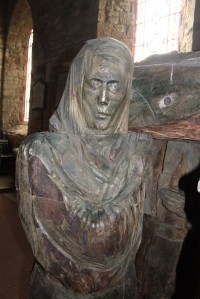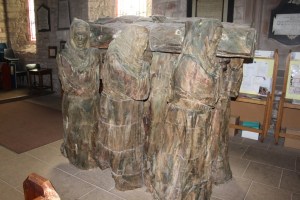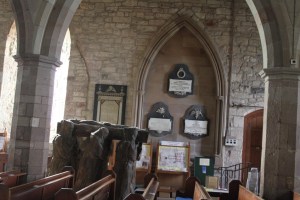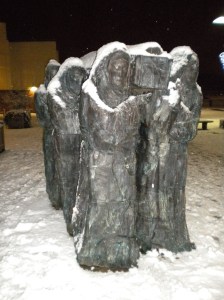From Howard’s Archaeodeath blog.
The post-mortem biography of St Cuthbert’s corpse and its successive contexts is long and complex and ongoing. It began before his death, with his life (death needs a life usually, but not always). It then continued with the first translation of his corpse and ran on through the journeys of his corpse until it reached Durham. Subsequently, the biography trundled forward through the embellishment and adaptation of his shrine and the repeated exhumation of his remains. Now his corpse cannot be exhumed any more (although you never know….) art fills a gap, allowing us to imagine not just his life, but his death and the journeys and translations of his relics.
The journeying of Cuthbert’s corpse is commemorated in a fascinating corporeal sculpture in elm wood by Fenwick Lawson. It was installed in, and subsequently dominates, the space of the south aisle of St Mary’s church, Lindisfarne.
Entitled ‘The Journey’, the sculpture depicts a narrow coffin with the body of St Cuthbert oddly raised above the edges of the coffin being borne by six monks frozen as if in movement. The focus is upon the monks and the coffin, but the corpse is clearly present, if difficult to see by anyone under 6 foot in height.
Representing something of the broader passion for hyper-real imagery to (over) emphasise the historicity as well as the corporeality of Cuthbert, this sculpture invokes imaginings of his post-mortem wanderings to his final resting place at Durham, the ceremony and the solemnity of that journey. It is a very rare example of an historic corpse depicted in translation in modern art.

 This is interesting for archaeologists because, despite our repeated interest in mortuary remains, we rarely depict corpses in translation like Fenwick Lawson has done with St Cuthbert. Corpses are usually on a pyre or in a grave, not moving towards their destinations.
This is interesting for archaeologists because, despite our repeated interest in mortuary remains, we rarely depict corpses in translation like Fenwick Lawson has done with St Cuthbert. Corpses are usually on a pyre or in a grave, not moving towards their destinations.
So the millennium-long obsession with Cuthbert’s cadaver, coffin and associated relics, thus finds a particularly striking form in this sculpture. It is but one of the ways in which Cuthbert is materialised in the church, opposite on the north wall is a replica of the images upon St Cuthbert’s coffin. Yet perhaps more than such replicas, Cuthbert’s identity and corporeality are powerfullyconveyed in the sculpture.
 A further fascinating dimension of this sculpture is how it has been replicated in bronze for Millennium Place, Durham. I first encountered this sculpture in 2010 whilst visiting Durham University for the Theoretical Archaeology Group annual conference. Viewed on a snowy evening before Christmas, it looked forlorn and lonely, still trudging towards a safe haven, casting imaginings of not only a corpse on its journey to a grave and shrine, but of a soul on its journey to Salvation.
A further fascinating dimension of this sculpture is how it has been replicated in bronze for Millennium Place, Durham. I first encountered this sculpture in 2010 whilst visiting Durham University for the Theoretical Archaeology Group annual conference. Viewed on a snowy evening before Christmas, it looked forlorn and lonely, still trudging towards a safe haven, casting imaginings of not only a corpse on its journey to a grave and shrine, but of a soul on its journey to Salvation.
As intriguing as the biography of Cuthbert’s human remains and other relics, and somewhat ironic in actual fact, is that the bronze version is now thought to be inadequately situated in Durham’s cityscape. There are plans to move it closer to Durham Cathedral.
So, just like his corpse, the sculpture has a biography in store for it, divided between two media – wood and bronze – and two locales intimately bound to the story of St Cuthbert: Lindisfarne and Durham.




